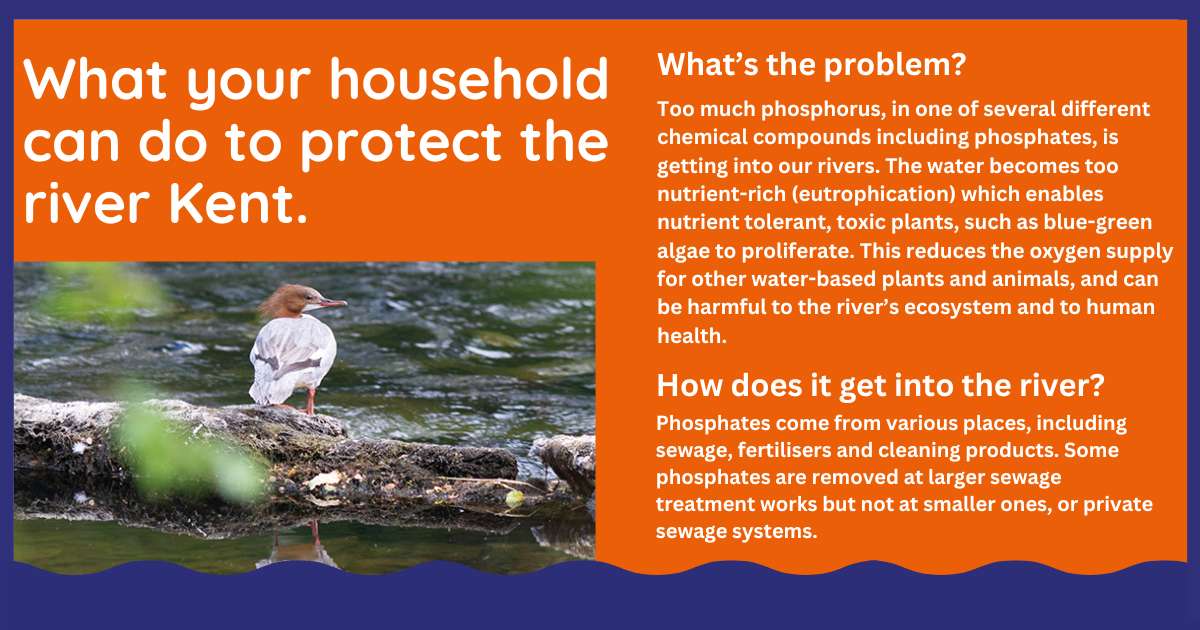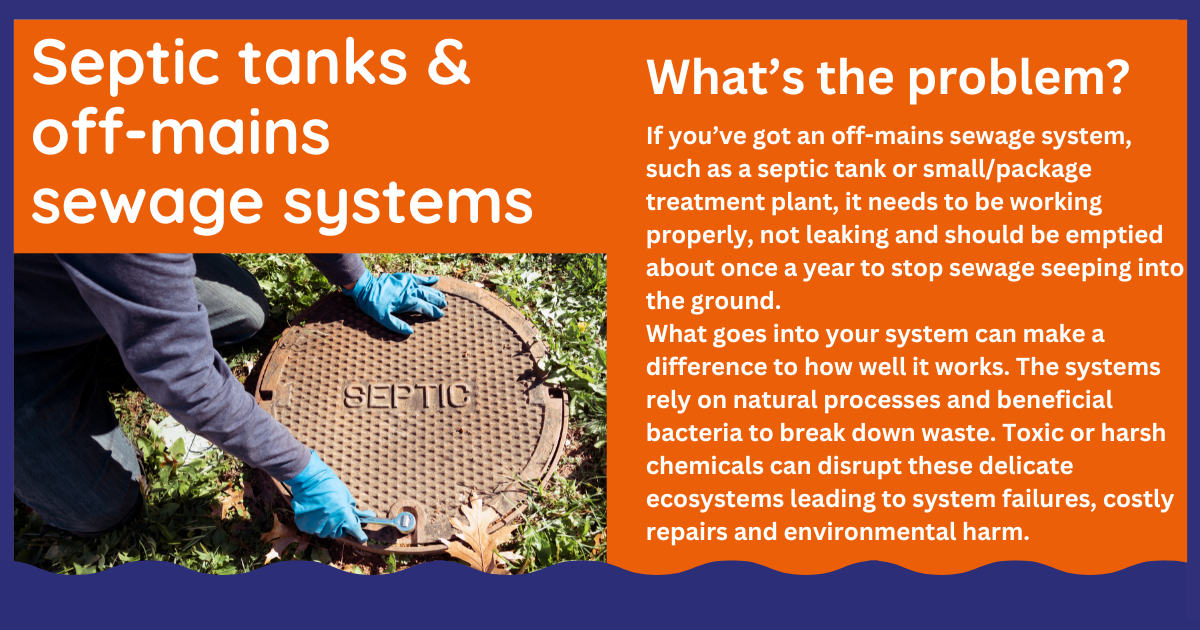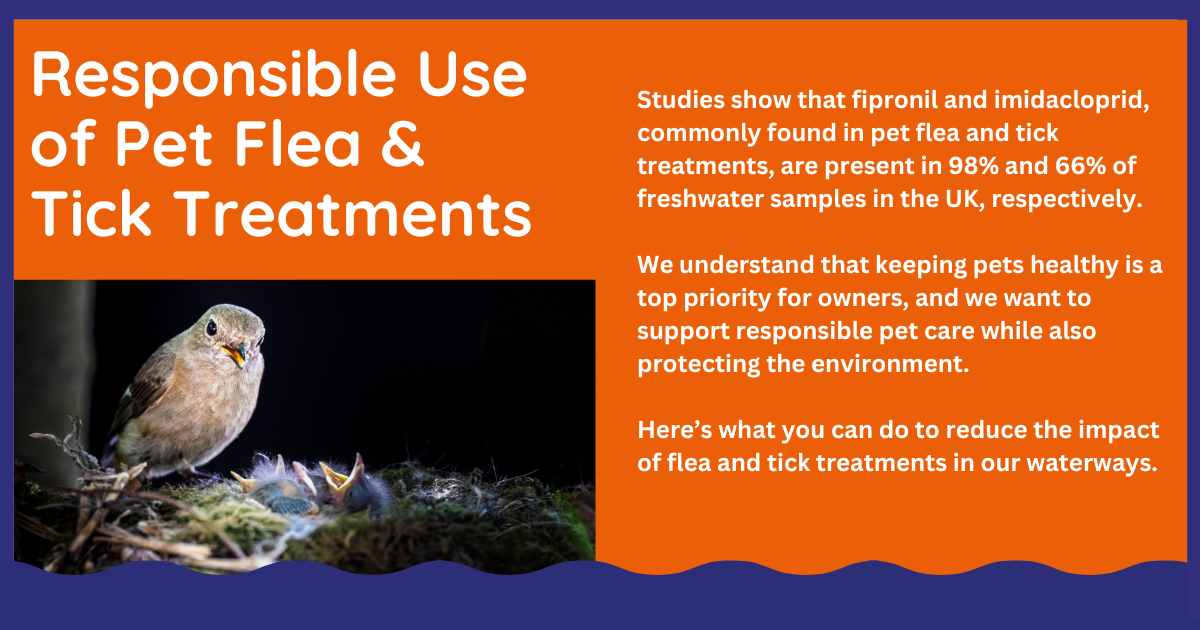Protect the River Kent: Simple Actions Your Household Can Take
The River Kent is a vital part of our local environment, home to diverse wildlife and an essential resource for our community. But too much phosphorus – from a range of sources, including agriculture (fertilizers and run-off), wastewater treatment works discharges and leaking septic systems – is harming its delicate ecosystem. Excess nutrients fuel toxic plant growth like blue-green algae, reducing oxygen levels and threatening aquatic life.
The Clean River Kent Campaign (CRKC) is dedicated to protecting our waterways, and you can help! If your home has an off-mains sewage system, ensuring it functions properly is crucial in preventing harmful pollution. Simple household changes, like reducing harsh chemicals and choosing environmentally friendly products in your house and garden, can also help.
Even everyday pet care choices matter—common flea and tick treatments contain chemicals that frequently end up in UK waterways. By making small adjustments, you can protect your pets and the river.
Join us in safeguarding the River Kent. Discover what your household can do to make a difference.

How can you help?
Think carefully about what you are putting down your sink, toilet & drains. Avoid products with harmful chemicals, especially phosphates. Switch to phosphate-free products wherever possible. Don’t flush anything other than pee, poo and paper – the 3 P’s. No oils, or food waste down the pipes either.
Cleaning
Phosphates are used in detergents to soften water, BUT did you know? Cumbria is a soft water area.
- Check the labels – Choose phosphate-free/low products for washing clothes and dishes – there are a wide variety of laundry soap, washing up liquid and dishwasher tablets at a range of prices from budget supermarket to premium range.
- Wash less often – Fill up your dishwasher and washing machine before using them.
- Spread the word – Tell other people about the phosphate issue and encourage them to go P-free too!
- Consider washing clothes less often – Spot clean where possible.
Think before you flush
In addition to reducing phosphates in the river, we also need to keep our sewage network and treatment plants working as effectively as possible.
- Only flush the 3 P’s – pee, poo and (toilet) paper. Never flush cleaning wipes, wet wipes, facial wipes, cotton buds, sanitary products, nappies or condoms and don’t use harsh chemicals or bleach.
- Be Sink Savvy – No harsh chemicals or bleach. Don’t pour food waste and cooking oils down your sink.
Garden Organically
- Organic gardening promotes horticultural practices with an awareness of the impacts of gardening on our surroundings. Some fertilisers consist of up to a third phosphate in their chemical composition and can lead to river pollution if they run off gardens directly into rivers and streams.
Grow Green, Keep our River Clean Tips
- Soil contains phosphate – Try to stop soil washing into watercourses where it can also contribute to sediment issues. Keep all your precious soil in your garden!
- Check the weather before applying fertiliser, compost or manure – Avoid applying before heavy rain. If your land borders a beck, stream or lake consider a margin of fertiliser-free land as a further precaution.
- Use a soil kit – Discover the specific nutrient your soil needs and then feed accordingly for optimum plant growth.
Use peat-free composts – We need to conserve our dwindling peat supplies as they serve various functions in the environment including conserving water and locking up carbon. - Install water butts – To capture rainwater off your roofs, and re-use in the garden.

In summary – how can I help?
- Keep your sewage system in good working order – through appropriate maintenance & servicing.
- Think carefully about what you are putting down your sink, toilet & drains.
- Avoid products with harmful chemicals, especially phosphates.
- Switch to phosphate-free products wherever possible.
- Don’t flush anything other than pee, poo and paper – the 3 P’s.
- No oils, or food waste down the pipes either.
Chemicals to avoid
Any chemicals that kill bacteria are not going to be safe for a septic tank – not only will they kill the bacteria in the home, but they can also kill the bacteria within the tank. In addition, some chemicals might not be broken down properly by the bacteria, meaning that they can be drained along with the water into the local area.
When considering household detergents, choose products that specifically have a label stating they are safe to be used with septic tanks. Eco-friendly products have been developed to have minimal impact on the environment, which means they typically have weak or no chemicals that could damage the bacteria within septic tanks.
Avoid any chemicals where gloves are required for use.
Phosphates
Although households are minor contributors of phosphates into our water systems compared to agriculture and sewage discharges, all phosphates can contribute to excess nutrient build-up in the system, potentially causing water quality issues. So choose laundry detergents and dish-washing soaps that are phosphate-free.
Chlorine (i.e. Bleach)
Chlorine is the main component in many household bleaches. It is a popular chemical that is used to disinfect but is harmful to ecosystems.
Alternatives:
Choose septic-safe or environmentally friendly cleaning products. These products are designed to be less harmful to septic systems and the environment.
Do not attempt to clean your septic pipe or septic tank. Not only is this a very dangerous task to do because of all the bacteria, but there are also different types of dangerous gasses that are released.
Moderate Use:
Use bleach and other cleaners only in moderate amounts and only use regular not strong versions. Dilute them with water before flushing them down the drains.
Solid bleach tablets or other solid cleaning additives may not dissolve properly and could cause clogs in the system.
Toilet Cleaners
Avoid using cleaners that contain bleach, ammonia, phosphates, or petroleum-based chemicals. Natural, plant-based cleaners are tough enough to clean your toilet and are safest for a septic tank.
Drain Cleaners
One of the most powerful chemicals in any household is drain cleaner. Liquid drain cleaners are typically safe for septic systems, but you should check the label and/or the Internet to be sure. Foaming or solid drain cleaners can disable your septic tank and will probably cause damage. If a waste pipe is blocked, such as your kitchen sink, then consider using boiling water and a Wastepipe Drain Blast Un-Blocker so that you avoid the chemical route.
White Spirit
- White spirit and other paint thinners can be very damaging to the environment in the drain field, so avoid putting them into your septic tank system.
- Never wash paint brushes or use brush-cleaning liquids in your sinks because they make your septic tank less efficient.
- Wash your paint brushes in a bucket, and then put cat litter in the bucket and leave it until it becomes hard so that you may put it in the bin.
- Always strain and reuse paint thinner, remembering to seal it properly.
- Paint thinner sludge needs to go to the correct disposal facility, or you can burn it if you wish.
Pesticides, weedkillers, etc.
Pesticides can damage the bacteria within a septic tank system.
Petrol
Avoid petrol getting into the septic tank.

In 2018, the European Union banned the use of neonicotinoids in agriculture due to their harmful impact on insects and bees.
In 2024 researchers from the University of Sussex analysed 103 blue and great tit nests that were lined with fur, finding that 100% of the nests contained fipronil and 89% contained imidacloprid. The scientists found a higher number of unhatched eggs or dead chicks in nests where there was a higher incidence of insecticide.
These chemicals can enter water systems in several ways, including:
- Pets swimming in rivers, lakes, and streams.
- Washing of pet bedding, hands, or surfaces that have come into contact with treated animals.
- Loose pet fur being used by birds for nesting material.
We understand that some pets and owners have higher risks of flea infestations, and preventative treatment may still be necessary in some cases.
- Consider using litter trays for cats to contain waste, allowing urine and faeces to be properly bagged and disposed of in the bin rather than in the garden.
- Keep dogs out of rivers and streams for a period after applying flea treatments.
- Be mindful that wild water bodies are home to delicate ecosystems, avoiding them, when possible, helps protect aquatic life.
Our goal is to encourage thoughtful, informed choices that balance pet health with environmental protection.
- Speak with your vet about risk-based approaches to flea treatment based on your pet’s lifestyle and exposure risk.
- Check your pet regularly for fleas using a flea comb before deciding on treatment.
- Look for flea and tick treatments that do not contain fipronil or imidacloprid.
- Consider products for pets formulated from organic and natural ingredients such as BIOGANCE.
- Injection or Flea tablets are an alternative to topical treatment, as they are less likely to contaminate water.
- If prevention/treatment is necessary, follow veterinary advice on responsible use and disposal to minimise environmental contamination.
